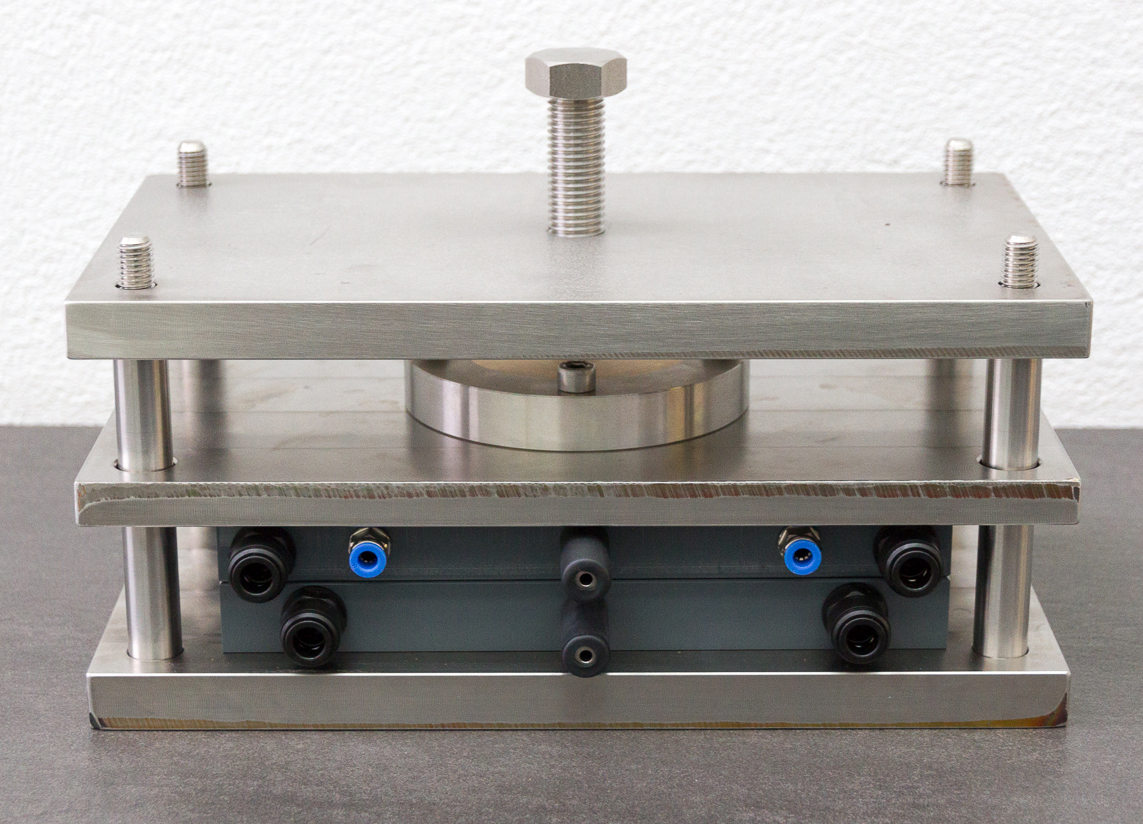Decentralized production of hydrogen peroxide – using surplus renewable power
In order to balance out spikes in power grids resulting from non-uniform regenerative energy conversion from wind or sun, surplus power can be used for the decentralized production of chemicals. Fraunhofer IGB has developed an electrolytic cell in which hydrogen peroxide can be produced on site with electric energy from just water and air – along with oxidative wastewater treatment. The IGB researchers are presenting a prototype electrolytic cell at the IFAT trade fair in Munich from May 30 to June 3, 2016.

Wood-colored pulp from which white paper is to be produced, objectionable tooth discolorations or disinfecting work areas in hospitals and food production facilities: Due to its highly oxidizing and cell toxic effects hydrogen peroxide is widely used as a bleaching agent and disinfectant in many technical areas, the production of cosmetics and medical applications. Hydrogen peroxide has also become firmly established in oxidative water treatment. Here, under the influence of ultraviolet light, hydrogen peroxide forms hydroxyl radicals: these destroy organic molecules that are not easily biodegradable.
For the most part hydrogen peroxide is produced on a large scale in centralized chemical plants, generally from oxygen and hydrogen and with a catalyst made of expensive platinum. As hydrogen peroxide can decompose spontaneously in highly concentrated solutions and explode, it can only be transported as a hazardous substance subject to strict safety precautions. This substantially increases the transport costs.
The Fraunhofer Institute for Interfacial Engineering and Biotechnology IGB has developed and implemented a new technical concept where hydrogen peroxide is generated locally and on the basis of demand in an electrochemical cell, that means with electricity alone – just from air and water. As a result of the turnaround in energy policy, there are non-uniform spikes in current supply from the regenerative production of energy. Thus the electrolytic production of chemicals is both becoming cost-effective and represents – in addition to the storage of energy – a practical utilization pathway for balancing out spikes in current supply to the grid.
Flexible synthesis in an electrolytic cell
The centerpiece of the development is a flat electrolytic cell. When an electric current flows, water is oxidized at the anode: protons are created and the pH value decreases. At the same time, atmospheric oxygen is reduced at the cathode, a gas diffusion electrode, which is also used for example in fuel cells. As a result, the protons are consumed and hydrogen peroxide is generated.
In a first demonstrator with 100 square centimeters of electrode area the researchers achieved concentrations of more than 400 milligrams hydrogen peroxide per liter when pure oxygen was supplied; when operating with ambient air as the source of oxygen, concentrations of 50 milligrams hydrogen peroxide per liter were obtained – with an energy requirement of 10 kWh/kg H2O2. Dr. Thomas Scherer, Group Manager at Fraunhofer IGB summarizes: “In the meantime we have further optimized the system. We were able to increase the yield from 50 milligrams to 1200 milligrams hydrogen peroxide per liter when operating with air and thus achieved the same turnover as when operating with pure oxygen.”
“Our system works without the use of chemicals. Additionally, our production of hydrogen peroxide is extremely flexible. When no surplus power is available, I simply switch off the electrolytic cell,” says Scherer. “Hydrogen peroxide that is not required immediately can be stored in a buffer tank and used as required.”
Modular and scalable prototype
The new electrolytic cell is operated as a flow-through cell. For transference to an industrially relevant scale, further cells can be connected in parallel or in series. Scherer explains the possibilities for scaling: “Individual electrolytic cells can also be stacked, for example as in fuel cell stacks. Such installations can then be designed on the basis of technical requirements and adjusted to the demand for hydrogen peroxide.”
For other application-specific developments and optimizations the process parameters can be modified and subcomponents in the demonstrator, such as the gas diffusion electrode, can easily be exchanged. By altering the temperature, current density, the volume flow and the composition of the solution, for example the pH value and the concentration of the solution can be adapted individually.
Proven operation in water purification
The decentralized electrolytic generation of hydrogen peroxide has already been successfully demonstrated in the field of water treatment. In a research project funded by the European Union, oxidative treatment with locally generated hydrogen peroxide was combined, in one treatment step, with adsorptive removal of contaminants from landfill leachate.
Next, the researchers plan to develop industrial applications where only small consumption volumes are required, for example the hygienization of plants and machines in the food industry or disinfection of surfaces in hospitals. For this purpose the researchers are still looking for interested partners to market the applications.
From May 30 to June 3, 2016 the researchers are presenting the cell at IFAT in Munich, at the Fraunhofer joint stand in Hall A5, Booth 217/316.
- more Information (Annual Report 2015/16) (www1.igb.fraunhofer.de)
 Fraunhofer Institute for Interfacial Engineering and Biotechnology IGB
Fraunhofer Institute for Interfacial Engineering and Biotechnology IGB